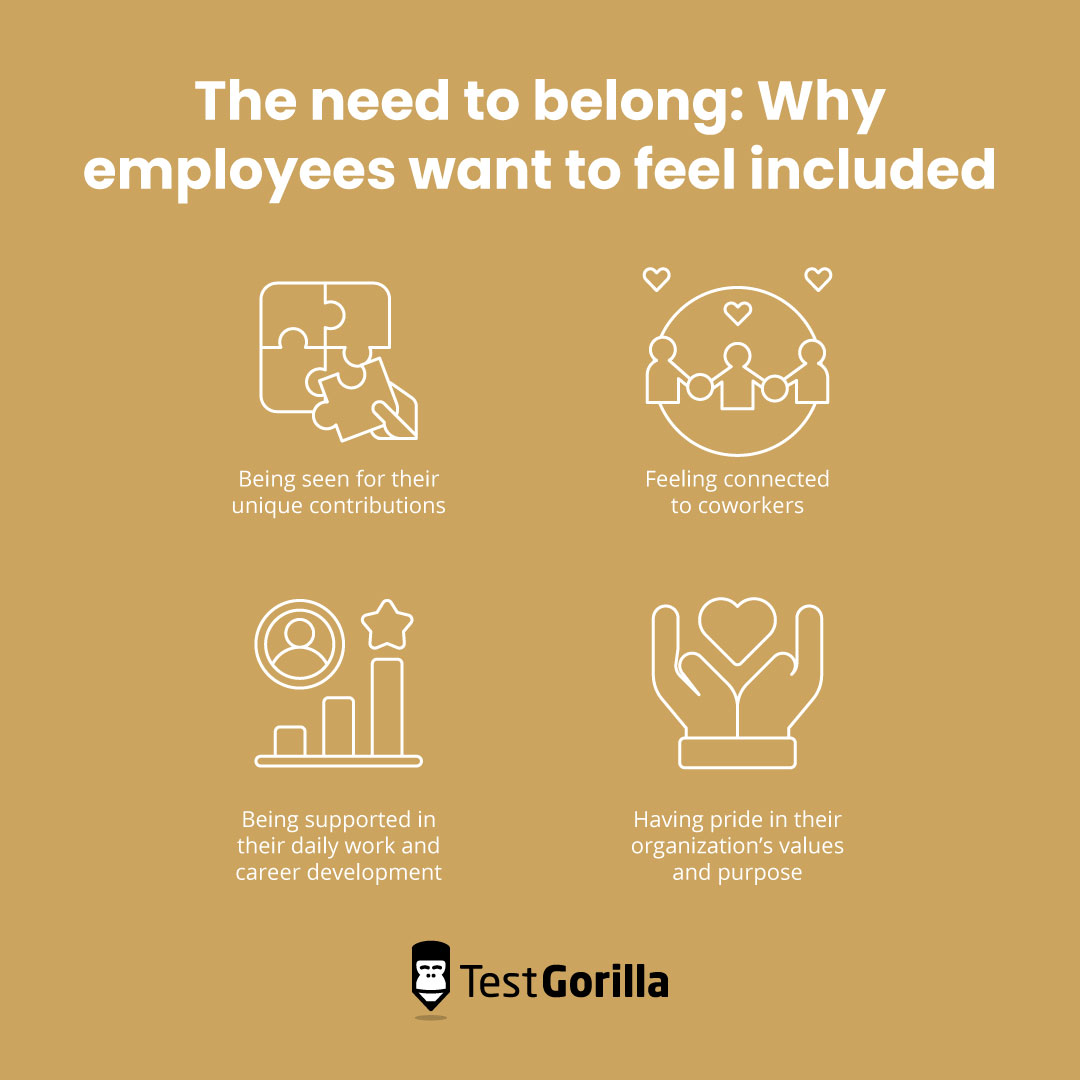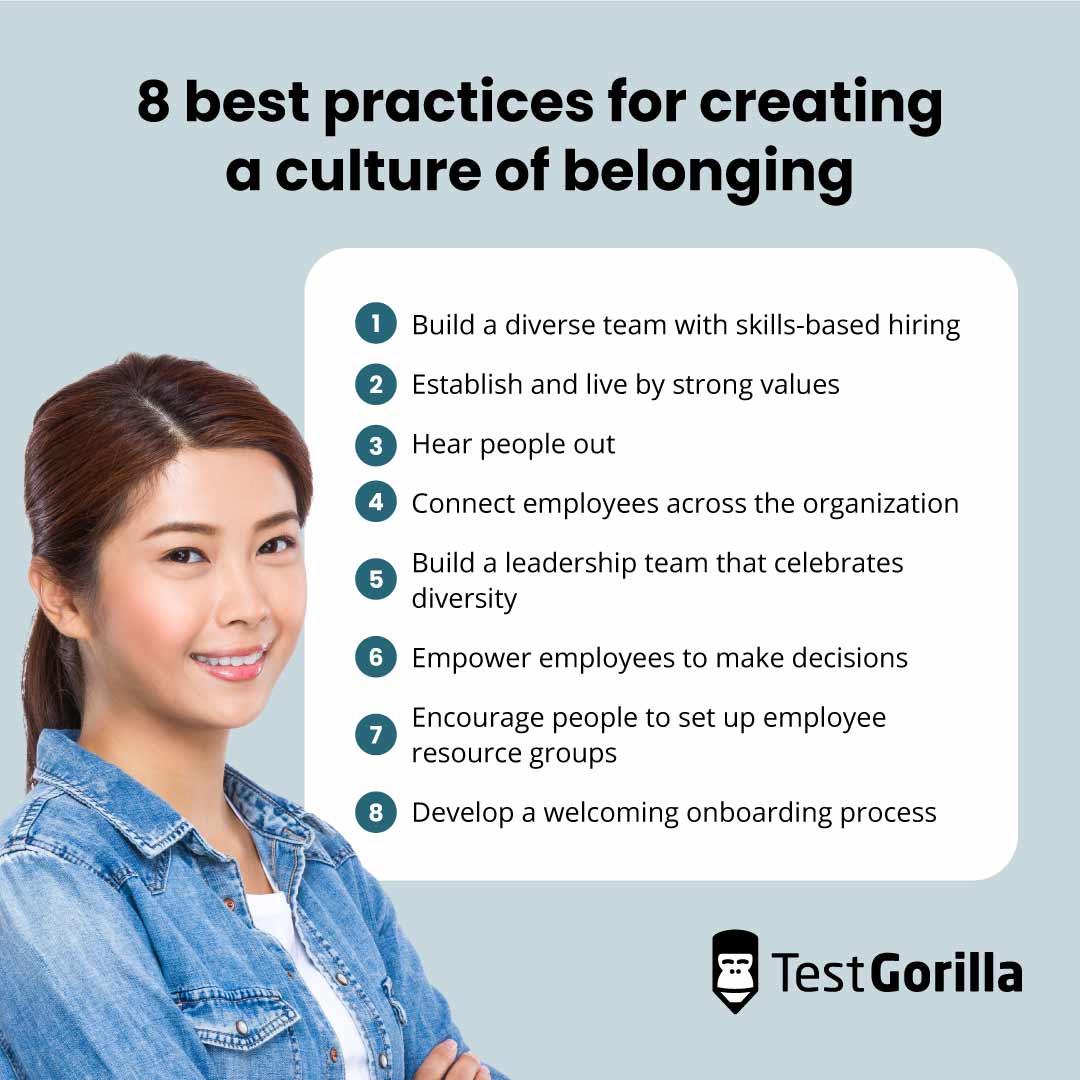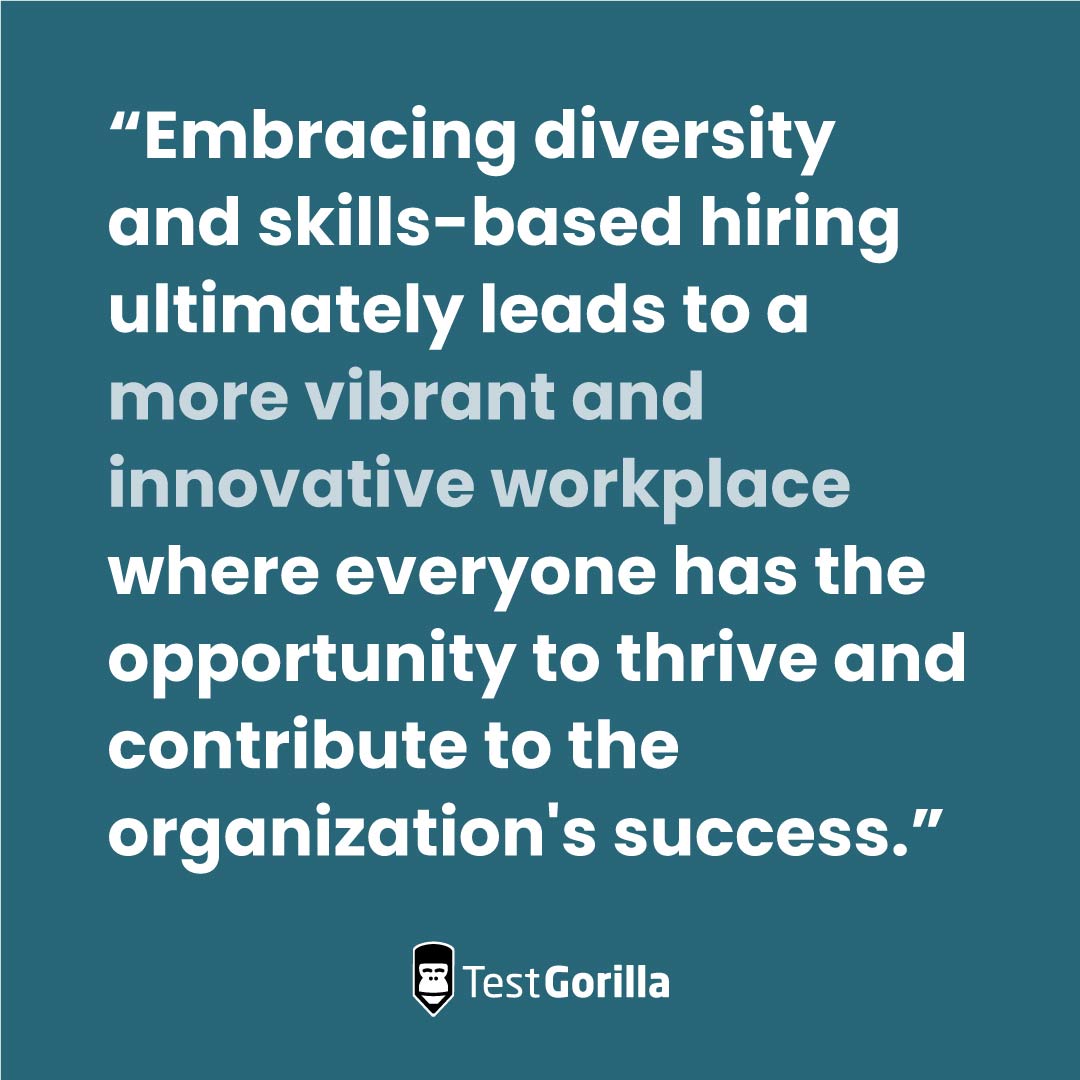How skills-based hiring can build a culture of belonging
When employees feel like they belong at work and are an integral part of a close-knit team, the results are far-reaching: Their job performance increases by 56%, their turnover reduces by 50%, and they take 75% fewer sick days.[1] Belonging is also cited as a leading driver of employee engagement, and 91% of employees who feel they belong are engaged at work as opposed to 20% of those who don’t.[2]
However, creating a culture of belonging at work involves more than offering a friendly welcome to new team members. It’s about building a diverse team and ensuring that everyone is treated equally and feels included.
Objective and data-backed recruitment practices like skills-based hiring help you do that by helping you hire for skills and ability, not subjective factors like background, union membership, or connections to existing staff.
In this article, we’ll examine how skills-based hiring helps companies increase diversity and improve employee happiness and retention. We’ll also look at how to use a skills-based approach to identify and develop the soft skills necessary for creating an inclusive and welcoming work culture, as well as provide practical tips for building a culture of belonging.
What is a culture of belonging?
Belonging plays a significant role in shaping the employees’ connection to their work environment and their overall sense of purpose at work. In a culture of belonging, individuals feel that they are valued for the unique qualities they bring to the workplace and they can feel safe expressing their true selves without fear of rejection or censure.
An opposite of this is a covering culture, where employees feel they must suppress aspects of their identities.
There are four key elements that contribute to creating a culture of belonging in your workplace. These factors influence how your people perceive their position within your organization and can foster a stronger sense of inclusion among your people, they are:
1. Being seen for their unique contributions
This speaks to recognizing and appreciating individual employees for their unique skills, talents, and contributions to an organization.
When this happens, your people feel acknowledged for who they are and what they do as individuals, as opposed to being just another number on your team roster. It shows that you see them as someone who brings a unique and valuable perspective to the table that can’t be easily replaced.
2. Feeling connected to coworkers
A sense of connection to coworkers comes from camaraderie, collaboration, and mutual support. Coworkers that can build positive workplace relationships feel a greater sense of belonging – helping to promote a people-centric organization and thriving workplace culture.
Coworkers that are connected to each other not only feel like they belong in their organization but are also more resilient and better equipped to work together. For example, teams that work cohesively are four times more prepared to respond to challenges than employees who don’t.
3. Being supported in their daily work and career development
This focuses on the short and long-term support employees receive from their managers and coworkers alike. When employees feel supported, whether it’s through adequate resources, guidance, mentorship, or opportunities for skill development, they’re more likely to experience a sense of belonging.
“Removing the expectation for perfection and creating an environment where it’s safe to fail and to iterate and grow is probably the most important part of belonging. I really enjoy celebrating a little failure from time to time. And doing so in a more public setting ensures everyone at all levels feels more comfortable.” – Nadia Vatalidis, Head of People and Culture at TestGorilla
4. Having pride in their organization’s values and purpose
When employees are aligned with and proud of your organization’s overall values, they feel a sense of shared purpose that fosters camaraderie, motivation, and engagement.
Since the pandemic, people’s values have changed and higher wages are no longer the most important incentive for working longer and harder. Fifty six percent of workers are unwilling to work for an employer that doesn't share their values, in a similar way to a consumer buying and remaining loyal to a brand because of its values.
How are belonging and D&I connected?
Helping employees feel a sense of belonging is directly tied to improving diversity and inclusion (D&I) in your organization, as both play a crucial role in establishing a cohesive and supportive work environment.
Embracing diverse perspectives fosters belonging
By embracing diverse perspectives, you let your people know that their unique identities and contributions are acknowledged and celebrated, which helps them feel like they belong.
This doesn’t mean people should conform to a single “cultural template” and try to blend in with everyone else on the team by adopting the same opinions and beliefs. Instead, it’s about celebrating individuals’ diversity of thought. [4]
As Nadia explains: “The more diverse your environment is, the more folks will feel like they can belong to the environment. Leadership representation (all the way up to executive level) is absolutely crucial too.”
Successful D&I initiatives improve belonging
By focusing on D&I efforts, you’ll also see an improvement in inclusion across your company. Gartner research shows that organizations with sustainable D&I initiatives increase inclusion by 20%. The result is greater on-the-job effort, improved employee performance, and an increased intention of staying at a company.[5]
Conversely, when there is a lack of diversity and inclusion in an organization, it can lead to lower rates of belonging — particularly among women and people of color.
For example, a report by McKinsey found that only 30% of women agreed that they could be themselves at work and that their opinions were valued.[6] The same report highlighted that 28% of women of color in leadership positions have experienced their judgment being questioned at work, which alienates them from the company and its people.
Inclusion is a pathway to belonging
Inclusion means creating equitable opportunities, fostering a culture of respect and fairness, and ensuring that everyone’s voice is heard and valued.
When you prioritize D&I, you help people from diverse backgrounds feel represented, heard, and valued. This improves the sense of belonging among employees by fostering an environment that respects and appreciates individual differences.
“My personal belief is that belonging is the direct outcome of all the collective people programs that companies create, as well as the behaviors of leadership that impact diversity, equity, and inclusion,” says Nadia. “If folks don’t feel like they belong at their organization, chances are leadership is failing at living out the company values and caring about D&I as a whole.”
By implementing skills-based hiring approaches and being more inclusive, businesses promote a culture where employees can bring their whole selves to work, feel involved in decision-making processes, and have equal access to growth and development opportunities.
The best insights on HR and recruitment, delivered to your inbox.
Biweekly updates. No spam. Unsubscribe any time.
3 examples of companies that succeeded in creating a culture of belonging at work
There are several examples of organizations that have taken steps to create a strong sense of belonging in the workplace and reaped amazing benefits as a result.
At multinational investment bank Citigroup the company's leadership group took part in a livestreamed global session in which they shared personal stories about times where they had felt excluded or unwelcome at work.
One anecdote that sparked a particularly strong reaction came from a senior executive who talked about how earlier in her career she would avoid conversations in which colleagues talked about their education because she was ashamed about not attending college.
These types of initiatives help to foster sense of connectedness within teams, and give confidence to employees who may feel uncomfortable expressing their true selves at work.
Another great example comes from biotechnology company Horizon Therapeutics. The organization makes a concerted effort to identify employees who demonstrate inclusive behaviors in the workplace. Traits that are singled out include "feeling comfortable speaking up and speaking out" and "owning and sharing their own story".
Thanks, in part, to these efforts Horizon has been recognized by Fortune magazine as one of the “Best Workplaces in Health Care and Biopharma” for several years running.
At real estate marketplace platform Zillow, allyship is one of the most important tools for creating a sense of belonging amongst employees.
According to the company's vice president of culture and community Rebekah Bastian, the company has set up at least eight affinity networks for different groups across the organization. Employees who are interested in demonstrating their allyship are encouraged to show their support by participating in group-specific Slack channels, affinity events, and by acting as sponsors or mentors to individuals within these networks.
8 best practices for creating a culture of belonging
The key to creating a culture of belonging is to set intentional policies and practices that help all team members feel they belong. Let’s explore eight best practices to help you do just that.
1. Build a diverse team with skills-based hiring
Skills-based hiring helps you attract and retain diverse candidates who might have been otherwise overlooked. This is good for both team belonging and business performance – ethnically diverse teams are 36% more likely to financially outperform non-diverse teams, while gender-diverse teams are 25% more successful. [7]
Rodolphe Dutel, CEO of Remotive, gives an example of how his organization implements skills-based hiring: “During the interview process, we create scenarios for potential employees to demonstrate their reactions. For instance, by asking them how they respond to angry customers, we replicate a real-life situation and give candidates a chance to show off their soft skills and empathy.”
For Rodolphe, the ideal candidate is someone who keeps calm during stressful situations like this. They can actively listen to their customers, acknowledge they’re upset, and provide actionable advice. They’re also looking for someone who is considerate of diverse cultural backgrounds and can communicate with empathy and respect.
Putting the candidate in a position where they can demonstrate those skills helps Rodolphe’s team hire the best person for the job, regardless of where they’re from or what they look like.
2. Establish and live by strong values
Establishing the right values creates a culture of belonging by helping employees feel connected to a shared purpose and core principles.
A strong set of company values can include principles like:
Putting talent first: Recognize that applying for a job is a high-stakes experience that can change someone’s life. To level the playing field for all global talent, give every candidate a fair chance by moving away from outdated hiring practices that rely heavily on resumes and referrals.
Supporting each other: Bring a positive attitude to work and trust that by working together, teams can solve any problem. You support each other best when you fully embrace your differences and respect diverse perspectives and experiences.
Radical candor: By providing feedback or sharing opinions in a straightforward yet respectful manner, you demonstrate genuine care for the well-being and growth of your team.
Show kindness and respect: Demonstrate kindness and respect by practicing active listening and showing empathy. These values are essential for fostering a positive and inclusive work environment.
Using skills-based hiring helps you recruit people who share the same values but have different backgrounds, experiences, and perspectives. For example, by giving candidates a culture add test, you can assess how their values and behaviors align with your organization’s values.
3. Hear people out
To understand how you’re doing at building a culture of belonging, send out surveys to check in with your employees. If one group reports a lower sense of belonging, take the time to start a conversation and understand the reasons why. Then, look for ways address the problem.
Ask clear and direct questions to get to the heart of the problem. Additionally, consider making these surveys anonymous to get a clearer view of how employees feel about their workplace environment.
Remember, to get the most honest answer from your people, you first need to cultivate a strong sense of psychological safety so they can be honest without fearing negative consequences. As well as surveys, you could even set up a culture committee to collect feedback on the ground.
4. Connect employees across the organization
Connecting with employees across the organization is vital for fostering a sense of belonging, as it creates a network of support and collaboration that transcends individual teams or departments.
To do this:
Encourage cross-functional collaboration
Organize team-building activities
Provide platforms for knowledge-sharing and open communication
By giving employees the opportunity to interact and collaborate with colleagues from different departments, you break down silos and promote a sense of unity and shared purpose. You also create an environment where individuals gain a deeper understanding of the diverse roles, perspectives, and expertise within the company.
5. Build a leadership team that celebrates diversity
Leaders should model inclusive behaviors, demonstrate empathy, and actively listen to employees’ perspectives. By encouraging your leaders to create a safe space for open dialogue, you can ensure that diverse voices are heard and valued.
By embracing skills-based hiring practices, your hiring teams can improve diversity across the organization all the way up to leadership, and build a stronger sense of belonging within the company.
This is why hiring teams should embrace skills-based hiring practices, both to improve diversity and contribute to a stronger sense of belonging within their company. According to our 2022 State of Skills-Based Hiring report, 91% of companies using skills-based hiring saw an increase in workplace diversity and other improvements in four key metrics:
Increase in employee retention (91.2%)
Reduction in mis-hires (92.5%)
Reduction in total time-to-hire (91.4%)
Reduction in total cost-to-hire (89.8%)
“Ensuring you build a culture of various backgrounds, regardless of qualifications and education, directly impacts the success of the company. This also creates accessibility for folks that often have fantastic skills and competencies but don’t qualify for certain roles, based on specific role requirements.” – Nadia Vatalidis, Head of People and Culture at TestGorilla
6. Empower employees to make decisions
When your people are empowered to make decisions, they have a greater sense of ownership over their work. This gives them the freedom to exercise their judgment, creativity, and expertise, enhancing their sense of identity and belonging within their roles.
By demonstrating confidence in your employee’s capabilities and providing a space to make decisions and learn from mistakes, you give them more autonomy and independence.
This helps them enhance their skills, knowledge, and decision-making capabilities. As employees feel supported and encouraged to grow, they develop a stronger sense of belonging — they see themselves progressing within the organization and advancing in their careers.
7. Encourage people to set up employee resource groups
Employee resource groups (ERGs), also known as affinity groups, are voluntary, employee-led teams designed to promote an inclusive, diverse, and supportive workplace. They play a pivotal role in creating a culture of belonging by providing a platform for employees to connect, collaborate, and support one another based on shared identities or interests.
You can support the formation of ERGs or affinity groups by:
Encouraging leadership endorsement and buy-in
Providing resources like funding, meeting space, and tech support
Organizing events, workshops, and initiatives that celebrate workplace diversity
Creating networking opportunities
Recognizing and celebrating their achievements
Run by employees for employees, TestGorilla’s LGBTQ affinity group TGplus is an example of how team members with a shared background can support each other. New employees find out about the affinity group when they first join the company and everyone is welcome to join either as a core member or an ally.
“The LGBTQ affinity group at TestGorilla is highlighted as part of the onboarding process so new employees are aware of its existence. Our ethos was always to raise awareness and to encourage all co-workers to be accepting, transparent, and show respect for each other.” – Otto Verhage, co-founder and COO at TestGorilla
8. Develop a welcoming onboarding process
Once through the hiring funnel, the onboarding process is where new recruits get their first real encounter with your company. By developing an onboarding process that goes beyond a basic orientation, you create an opportunity for new hires to feel welcome and included right from the start.
In addition to sharing information about values and D&I initiatives, assign mentors or buddies to help new hires navigate the organization and foster connections from day one.
Finally, ensure that decision-making bodies, leadership teams, and project teams include individuals from different backgrounds and perspectives. It’s important to actively work towards diverse representation at all levels of the organization so new hires feel they belong no matter what role they’re in.
Pro Tip: Use a leadership & people management test to hire diverse leaders who will help support employee development and foster a sense of belonging.
Nurturing a sense of belonging with the power of skills-based hiring
Employees who feel like they’re part of a close team in the workplace are happier, work harder, and are more likely to stick around as loyal employees.
That’s why a culture of belonging isn’t just a ‘nice-to-have’ but a ‘need-to-have’ to instill a sense of belonging in your workforce.
Take the necessary steps to develop a culture of belonging by:
Recognizing that belonging and D&I are closely linked
Establishing and living by strong values
Creating an ethos of transparent communication
Empowering employees to make decisions
Building diverse teams through skills-based hiring
Embracing diversity and skills-based hiring ultimately leads to a more vibrant and innovative workplace where everyone has the opportunity to thrive and contribute to the organization’s success.
By embracing skills-based hiring, you can create an environment that values and celebrates the unique contributions of each employee and helps them feel they form a vital part of your organization.
Want to create a culture of belonging? Skills-based hiring helps you build a diverse team of top talent with the right skills. Download the State of Skills-based Hiring 2022 report to learn more
Sources
“The Value of Belonging at Work: Investing in Workplace Inclusion.” (n.d.) BetterUp. Retrieved June 20, 2023. https://grow.betterup.com/resources/the-value-of-belonging-at-work-the-business-case-for-investing-in-workplace-inclusion-event
“2021 Employee Experience Trends.” Qualtrics. Retrieved June 20, 2023. https://success.qualtrics.com/rs/542-FMF-412/images/Qualtrics-2021-Employee%20Experience-Trends.pdf
“The Power of Belonging: What It Is and Why It Matters in Today’s Workplace.” Coqual. Retrieved June 20, 2023. https://coqual.org/reports/the-power-of-belonging/
“Belonging: From comfort to connection to contribution.” (2020) Deloitte Insights. Retrieved June 20, 2023. https://www2.deloitte.com/us/en/insights/focus/human-capital-trends/2020/creating-a-culture-of-belonging.html
“3 ways to build a sense of belonging in the workplace.” (2022) Gartner. Retrieved June 20, 2023. https://www.google.com/url?q=https://www.gartner.com/smarterwithgartner/build-a-sense-of-belonging-in-the-workplace
“Women in the workplace.” (2022) McKinsey. Retrieved June 20, 2023. https://www.mckinsey.com/~/media/mckinsey/featured%20insights/diversity%20and%20inclusion/women%20in%20the%20workplace%202022/women-in-the-workplace-2022.pdf
“Diversity wins: How inclusion matters”. (2020) McKinsey. Retrieved June 20, 2023. https://www.mckinsey.com/featured-insights/diversity-and-inclusion/diversity-wins-how-inclusion-matters
You've scrolled this far
Why not try TestGorilla for free, and see what happens when you put skills first.

















